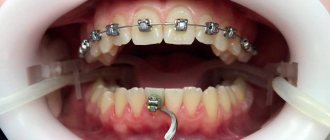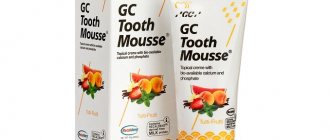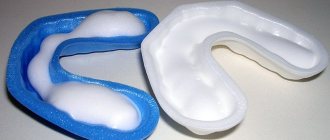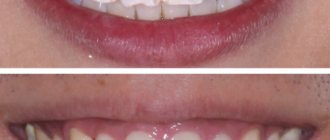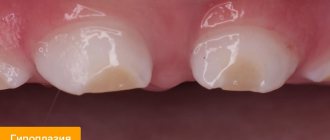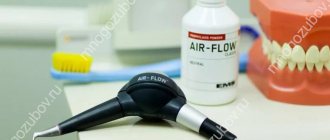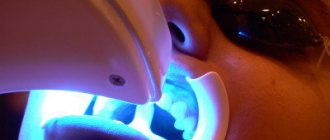Aesthetic enamel defects can be removed using an effective and painless micro-abrasive method. This cosmetic procedure will help treat shallow tissue and dark formations in just a few sessions. Our clinic offers services for whitening stains on enamel using microabrasion using modern materials.
Indications for the procedure
If you are offered microabrasion, then there are probably the following indications for this:
- unsightly and uneven enamel color, stains that could not be removed with the help of professional oral hygiene and for which whitening alone is not enough,
- spotted hypoplasia,
- the initial stage of fluorosis in streaked and spotted forms: for erosive and destructive types of the disease, the procedure is not performed,
- the presence of areas of enamel demineralization: the procedure can be carried out as a caries prevention, as an addition to remineralization or fluoridation,
- white spots and unevenness on the enamel after removing braces.
Results and discussion
Patient K
., 18 years old, teeth color correction by 10 shades according to the reorganized Vita scale.
The patient is satisfied with the treatment result (Fig. 5). To carry out remineralization therapy, the patient was recommended toothpaste and suspension containing nanohydroxyapatite for 1 month. After using the preventive measures, the patient was advised to refrain from eating and drinking water for 2 hours. It should be noted that for 2 weeks from the diet of
patient K. All coloring products were excluded. After 1 month, the patient was scheduled for another appointment. Teeth with a chalky-mottled form of fluorosis that had undergone microabrasion appeared shiny due to the process of enamel remineralization, and the patient noted a significant improvement in dental aesthetics and quality of life.
Rice.
5. Patient K., 18 years old. Chalky-mottled form of fluorosis. Result after treatment. Thus, the microabrasion method makes it possible to effectively correct the color of teeth with fluorosis, on the basis of which this method is recommended for use in practical healthcare for the treatment of discolored teeth.
The authors were equally involved in the preparation of the material.
There is no conflict of interest.
What are the contraindications
Removal of a thin layer of enamel is contraindicated in the following pathologies and conditions:
- severe thinning or destruction of hard tissues (including cracks and chips),
- multiple caries,
- erosion and wedge-shaped defect,
- advanced stages of fluorosis and hypoplasia (including erosive, grooved, mixed),
- bleeding gums and exposure of tooth roots.
The procedure is not performed on baby teeth or on pregnant and lactating women. Microabrasion is not performed on pulpless, that is, nerveless, elements. Its use is inappropriate for such a defect as tetracycline staining, as well as after treatment with resorcinol-formalin compounds.
The microabrasion procedure may have contraindications
Important! The success of microabrasion largely depends on the correct definition of the clinical case. If the treatment method is chosen incorrectly, it can disappoint the patient. After all, the procedure can only eliminate superficial discoloration of the enamel.
Efficiency and safety of the procedure
Microabrasive treatment makes it possible to completely remove pigmented stains on the surface of teeth, as well as stop carious processes at the very beginning of their development. Thus, this is not only a solution to an aesthetic problem, but also a prevention of further rapid destruction of dental tissue under the influence of pathogenic bacteria. According to statistics, the effectiveness of the procedure is 50%2. This means that the success of treatment largely depends on the age of the patient and the depth of the lesion. Enamel is easier to process and recovers faster if the patient is young enough. Over the years, dental tissues become less amenable to this type of therapy, but it still makes it possible to avoid severe grinding and installation of an artificial crown.
Teeth may become sensitive
The most common complication of microabrasion is increased sensitivity of the enamel. To reduce the severity of the symptom, the patient must strictly follow the doctor's recommendations after the procedure. To alleviate the condition and speed up the recovery process, experts recommend rinsing with a 10% calcium gluconate solution. You can buy it at any pharmacy, but before using it, it is better to consult a doctor. The first time after microabrasion, you should use hygiene products for sensitive teeth and try to avoid consuming sour and spicy foods. Also make sure that the food is not too hot or cold.
It is important that the doctor has a high level of professionalism and relevant experience. Mistakes made by a specialist during the procedure can provoke the appearance of erosive areas on the enamel and injured areas on the gums. To eliminate such complications, the patient will have to treat the affected areas with antiseptic agents, drugs with wound healing and anti-inflammatory effects.
- Greenwall L. Whitening techniques, 2003.
- According to WHO.
Features of the method
- Enamel microabrasion is considered a minimally invasive procedure. It is painless and does not require anesthesia. It feels like an Air-flow procedure, polishing a filling or, for example, facial peeling. The result is achieved in 1 session.
- When enamel microabrasion is performed, according to various sources, on average, from 15 to 60 microns of hard tissue are removed, depending on the clinical situation.
- To remove the required thickness, doctors use various gels and suspensions, which may include pumice, hydrochloric acid, and silicon carbide microparticles. The gel is rubbed into the enamel using special brushes and rubber cups.
- After microabrasion, a smooth surface is formed on the enamel that reflects light well, and therefore visually the tooth looks whiter and healthier.
Expert opinion
Elina Ruslanovna Dzagurova
Specializations: Dentist-therapist
Experience: 11+
“To achieve a better effect, microabrasion is often used in the treatment of hypoplasia and other forms of discoloration in addition to other measures: bleaching, remineralization and fluoridation courses, artistic restoration with adhesive materials.”
Material and methods
At the clinical base of the Department of Clinical Dentistry, Faculty of Dentistry, Moscow State Medical University named after. A.I. Evdokimov was contacted by patient K
., 18 years old, with complaints of chalky and yellow-brown spots, aesthetic dissatisfaction and reluctance to smile freely (Fig. 1).
Rice.
1. Patient K., 18 years old. Chalky-mottled form of fluorosis. Objectively: on the vestibular surfaces of the teeth of the upper and lower jaws there are yellow-brown spots with clear boundaries on a matte chalky enamel background; the patient does not notice any painful sensations.
The configuration of the face is not changed, upon palpation the regional lymph nodes are painless, soft-elastic consistency, mouth opening is free. The mucous membrane of the mouth is pale pink, moderately moist. According to the patient, he considers himself practically healthy and has no allergy history.
Diagnosis: according to ICD-C K00.3 - dental fluorosis (chalky-mottled form of dental fluorosis).
Treatment: the working field was isolated (teeth 1.6-2.6, 3.6-4.6) using liquid cofferdam (Fig. 2), then according to the scheme proposed by N.I. Kriheli (2008) [8], microabrasion of the teeth was performed using a special set (Fig. 3, 4). Teeth polishing was carried out using the means provided in the microabrasion kit (Fig. 4). Color changes were recorded using the Vita scale reorganized in chromatic order.
Rice. 2. Patient K., 18 years old. Chalky-mottled form of fluorosis. Rubber dam application.
Rice. 3. Set for enamel microabrasion.
Rice. 4. Patient K., 18 years old. Chalky-mottled form of fluorosis. Carrying out microabrasion of enamel.
Stages of the procedure
Regardless of the pathologies for which microabrasion is performed: fluorosis, hypoplasia, or simply pigmentation of the enamel, the essence and order of the procedure does not change.
| Stages | Description |
| First stage | The doctor assesses the condition of hard tissues, visually examines them, and identifies boundaries and areas of discoloration. |
| Second phase | Removing soft and hard plaque from the surface of teeth in order to best prepare them for exposure to abrasive compounds. |
| Third stage | Protection and isolation of the soft tissues of the oral cavity using a rubber dam or rubber dam. |
| Fourth stage | Applying an abrasive mass, rubbing it into the enamel using rubber cups, which are set to rotate slowly. The procedure lasts about 30-60 seconds. |
| Fifth stage | Rinsing the tooth with a water-air spray. The decision to re-use abrasives (for better effect, the procedure can be repeated 2-3 times at intervals of 60 seconds). |
| Sixth stage | Strengthening enamel using a remineralizing gel or fluoridated prophylactic composition. |
“While wearing braces, white spots appeared on my teeth. This became especially noticeable after removing the plates. To be honest, at first I was very upset, because even though my teeth were straight, these stains were not at all what I expected to see as a result of long-term treatment. I thought I'd have to bleach it. But the doctor suggested a better solution - microabrasion. In principle, after this, the teeth began to look very good, and those around them generally thought that they were perfect. So I recommend it!”
Orange, review from woman.ru
Step-by-step description of the process
To begin, the patient must sit comfortably in the dental chair. Despite the fact that the procedure is completely painless and does not require prior administration of anesthesia, it is important to create a psychologically comfortable environment for the person so that he can relax and allow the doctor to work in peace. Once the patient is ready, a special composition will be applied to his teeth, which includes hydrochloric acid, carborundum and silicon abrasive gel. The product is applied to the enamel using a special rubber nozzle. The paste is left for a while to soften the enamel layer a little. Afterwards it is removed using special rubber cups.
So, enamel microabrasion involves the following steps:
- First, the specialist isolates the treatment area from the mucous membrane and neighboring healthy teeth. For this, a special gel can be used, for example, “Axil” or rubber dam,
- then the dental retractor is fixed,
- an abrasive mass is applied to the surface of the enamel,
- the product is gently rubbed into the dental tissues, usually using special rotating rubber cups,
- excess mixture is removed,
- Remo-gel is applied to the affected area, stimulating the processes of restoration of damaged enamel and replenishing the lack of minerals in dental tissues,
- remineralization – carried out if there are appropriate indications,
- At the final stage, the doctor evaluates the result of treatment, advises the patient, and gives him a reminder about further dental and oral care.
The photo shows the application of the gel to teeth during microabrasion.
If there is such a need, the procedure is repeated. The duration of the rehabilitation course directly depends on the degree of contamination of the teeth and the depth of the spread of carious processes.
Advantages of the method
The procedure is simple to perform and can be used on permanent teeth in adults and adolescents (which cannot be said about whitening). In case of superficial enamel discoloration, microabrasion allows you to quickly and painlessly achieve good results, making your teeth aesthetically more attractive, white and shiny. Another advantage is that the procedure, if the tooth is intact and has not undergone severe destruction, helps to avoid more invasive intervention and refuse the installation of orthopedic structures. For example, crowns.
Before and after the operation
A number of studies suggest that hard tissues subjected to microabrasion are less susceptible to demineralization processes than those that were not treated. They show less colonization of carious bacteria, the main causative agents of caries - Streptococcus mutans.
Microabrasion – gentle polishing of enamel to remove plaque and prevent caries
Every day, the enamel of our teeth is affected by a huge number of external factors.
Excessive consumption of sweets, coffee and tea, smoking - all this leads to gradual demineralization of the protective layer of teeth and, as a result, a change in its color. It is important to understand that this is not only an aesthetic problem. Under bacterial plaque, hard tissues are quickly destroyed, which in the absence of regular hygiene inevitably leads to the onset of carious processes. The situation can be corrected in the early stages using a microabrasion procedure. Microabrasion
is a gentle polishing of teeth to remove pigmented areas and prevent the development of caries. Most often, such changes include white spots, which cause aesthetic discomfort to patients.
Read more about what it is and when the technique is used further in this material.
Diagnosis of dental fluorosis
High-quality differential diagnosis is the key to successful treatment and determination of adequate therapeutic tactics. The professionalism of the dentist is important; based on the results of a visual examination, clinical symptoms and anamnesis, he can determine the form and extent of the disease at the first appointment. A dental examination is carried out according to a standard procedure.
- Mild cloudiness of the enamel is detected by drying the surface, which makes it possible to assess the condition of the protective coating in the area of pigmentation changes.
- The vital staining technique is effective - in case of fluorosis, damaged areas of enamel are not exposed to methylene blue dye.
- Determination of the degree of dental damage is carried out using luminescent diagnostics. A mild form of the disease in ultraviolet rays manifests itself as a weak glow; with moderate and severe degrees, partial quenching of fluorescence is observed.
- To exclude caries, microradiography is prescribed. The study also allows us to determine the depth of the lesion in the middle and deep layers of dentin.
Changes in enamel pigmentation may be associated with other pathologies or a lack of vitamins D and A. In this case, the condition of connective tissues worsens, bone fragility, a tendency to inflammatory processes in the gums and roughness of the surface of the teeth are noted.
Advantages and disadvantages
The advantages of this technique include the following:
- no special preparation is required before the procedure;
- dental procedures are painless and do not cause discomfort to the client;
- if the result is positive, this will help avoid tooth preparation for further restoration.
Of the minuses, it is worth noting the following:
- a large number of contraindications;
- microabrasion can cause excessive sensitivity.
Indications and contraindications
Indications for microabrasion of a tooth:
- Change in enamel color - brown spots, chalky spots, darkening of the tooth.
- Fluorosis.
- Areas of demineralization.
- Contraindications:
- Individual hypersensitivity to individual components of the composition.
- Cracks in the enamel.
- Severe depletion of the top layer.
- Pregnancy and breastfeeding.
Microabrasion of teeth is a modern and safe procedure that allows you to get rid of stains on teeth, darkening of enamel color, fluorosis and other similar problems. But only qualified specialists in a dental clinic will be able to select the appropriate composition, determine the exposure time and the thickness of the layer to be removed.
Basic treatment methods
Therapeutic tactics depend on the form and clinical manifestations of the disease. In addition, the patient must send the water he consumes for laboratory analysis, which determines the percentage of microelements.
For mild cases, local treatment and bleaching (laser, LED or chemical) followed by remineralization are effective. For these purposes, medicinal solutions containing calcium and phosphorus compounds are applied to tooth enamel by application or electrophoresis.
The course of treatment consists of 10-15 procedures. Replacement therapy optimally compensates for the loss of minerals from tooth enamel. In addition, long-term use of calcium gluconate and glycerophosphates is prescribed. The treatment has a lasting effect, however, to consolidate the positive dynamics, repeated courses of therapy are recommended after 8-10 months.
Brown or yellow spots with moderate damage are removed using microabrasion. The procedure is performed by a doctor and involves applying a paste containing acid and abrasive particles. One or two procedures are enough to solve the problem.
In case of pronounced defects and destruction of hard structures, the shade and shape of the crown part is restored with photocomposites, orthopedic structures, porcelain or ceramic onlays (veneers or lumineers). In some cases, pins are used to secure teeth.
Treatment of fluorosis
How to treat dental fluorosis? In both children and adults, treatment of fluorosis must begin with reducing the dose of fluoride that enters the body. If it is not possible to completely replace the water you use, I recommend using special filters for defluoridation. You should also completely avoid toothpastes containing fluoride and eat less fluorinated foods (sea fish, spinach, animal oil, tea). All these actions will not help eliminate existing stains on the enamel, but will stop the further development of the disease.
